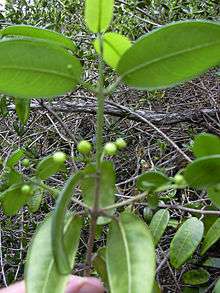Melicope
| Melicope | |
|---|---|
 | |
| Melicope clusiifolia | |
| Scientific classification | |
| Kingdom: | Plantae |
| (unranked): | Angiosperms |
| (unranked): | Eudicots |
| (unranked): | Rosids |
| Order: | Sapindales |
| Family: | Rutaceae |
| Subfamily: | Toddalioideae |
| Genus: | Melicope |
| Species | |
|
About 150, see text | |
| Synonyms | |
|
Pelea A.Gray | |
Melicope is a genus of about 230 species of shrubs and trees in the family Rutaceae, occurring from the Hawaiian Islands across the Pacific to tropical Asia, Australia and New Zealand. The temperate Asian genus Tetradium (which sometimes include the tropical Euodia) is closely related to Melicope and is sometimes merged into it.[2][3]
In Australia they are known as doughwoods, or more ambiguously as "corkwoods" or "euodias", and in Hawaii they are collectively called alani; the Māori term wharangi for Melicope ternata is a cognate of that. Generally, these plants are simply called melicopes or (after a formerly independent genus now included in Melicope[4]) peleas.
Several of the Hawaiian species are listed as federally endangered due to habitat loss and competition from invasive non-native plants. A few species are completely extinct already.
They are foodplants for various animals, mainly invertebrates. Caterpillars of the Ulysses butterfly (Papilio ulysses) are fond of M. elleryana; on M. clusiifolia caterpillars of Thyrocopa moths have been found. The larvae of some belid weevils from the genus Proterhinus also feed on Melicope; they prefer unhealthy, dying or dead specimens. But the plants may not be safe for humans — the nectar at least of Wharangi is known to yield toxic honey that may kill whoever eats it.[5]
Taxonomy
The generic name is derived from Greek words μελι (meli), meaning "honey," and κοπη (kope), meaning "a division," referring to the glands at the base of the ovary.[6] The Takhtajan system places the genus in the subfamily Rutoideae, tribe Zanthoxyleae,[7] while Germplasm Resources Information Network places it in the subfamily Toddalioideae and does not assign it to a tribe.[1] Evidence from 2009 indicates that the related genus Platydesma of four species is nested within the genus Melicope and is sister to all Hawaiian Melicope species. And while Melicope species are dioecious (individual plants only bear either male or female flowers), the flowers of Platydesma are hermaphroditic, suggesting a rare evolutionary reversion away from dioecy in Platydesma.[3] Molecular phylogenetic analyses also suggest that the genera Comptonella, Dutaillyea, Picrella, and possibly Dutailliopsis, all from New Caledonia, are also nested in Melicope.[8]
Selected species
|
|
Footnotes
| Wikimedia Commons has media related to Melicope. |
| Wikispecies has information related to Melicope |
- 1 2 "Genus: Melicope J. R. Forst. & G. Forst". Germplasm Resources Information Network. United States Department of Agriculture. 2008-03-21. Archived from the original on 2012-09-27. Retrieved 2009-02-06.
- ↑ Hartley (2001)
- 1 2 Harbaugh, D.T.; Wagner, W.L.; Allan, G.J.; Zimmer, E.A. (2009). "The Hawaiian Archipeligo is a stepping stone for dispersal in the Pacific: an example from the plant genus Melicope (Rutaceae)". Journal of Biogeography. 36 (2): 230–241. doi:10.1111/j.1365-2699.2008.02008.x.
- ↑ Hartley & Stone (1989)
- ↑ Espina-Prez & Ordetx-Ros (1983): p.35
- ↑ Quattrocchi, Umberto (2000). CRC World Dictionary of Plant Names. III: M-Q. CRC Press. p. 1652. ISBN 978-0-8493-2677-6.
- ↑ Takhtajan, Armen (2009). Flowering Plants (2 ed.). Springer. p. 375. ISBN 978-1-4020-9608-2.
- ↑ Appelhans MS, Wen J, Wagner WL (2014). "A molecular phylogeny of Acronychia, Euodia, Melicope and relatives (Rutaceae) reveals polyphyletic genera and key innovations for species richness". Mol. Phylogenet. Evol. 79: 54–68. doi:10.1016/j.ympev.2014.06.014. PMID 24971739.
- ↑ "Mokihana". Native Hawaiian Plants. Kapiʻolani Community College. Archived from the original on 2009-03-23. Retrieved 2009-03-07.
- ↑ Little Jr., Elbert L.; Roger G. Skolmen (1989). "Alani, clusia-leaf pelea" (PDF). United States Forest Service.
- ↑ "ʻAlani". Native Hawaiian Plants. Kapiʻolani Community College. Archived from the original on 2009-09-18. Retrieved 2009-03-02.
- ↑ "Melicope". Integrated Taxonomic Information System. Retrieved 2010-11-29.
- ↑ "GRIN Species Records of Melicope". Germplasm Resources Information Network. United States Department of Agriculture. Archived from the original on 2000-11-02. Retrieved 2010-11-29.
References
- Espina-Prez, D. & Ordetx-Ros, G.S. (1983): Flora Apcola Tropical [in Spanish]. Editorial Tecnolgico de Costa Rica, Cartago, Costa Rica.
- Hartley, Thomas Gordon (2001): On the taxonomy and biogeography of Euodia and Melicope (Rutaceae). Allertonia 8(1): 1-328.
- Hartley, Thomas Gordon & Stone, Benjamin Clemens (1989): Reduction of Pelea with new combinations in Melicope (Rutaceae). Taxon 38(1): 119–123. First page image
External links
- "alani, alani kuahiwi". Hawaiian Ethnobotany Database. Bernice P. Bishop Museum.
- "Melicope J.R.Forst. & G.Forst". Atlas of Living Australia.
